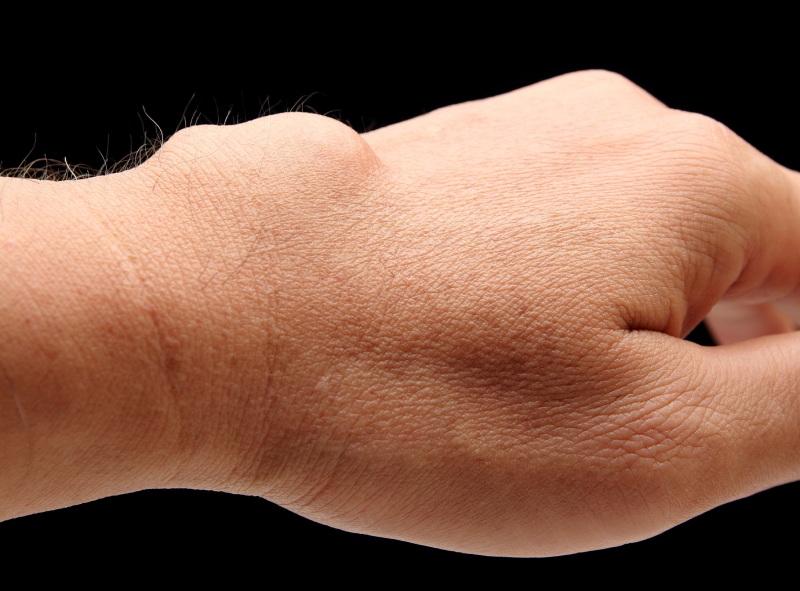What is a Ganglion Cyst?
A ganglion cyst is a benign (non-cancerous), fluid-filled lump that typically develops along the joints or tendons of the wrists, hands, ankles, or feet. These cysts are most frequently observed on the dorsal (top) side of the wrist, although they can also appear on the palm side, near the fingers, or even at the base of the thumb. The cyst is filled with a gelatinous, jelly-like synovial fluid, which is similar in consistency to the natural fluid that lubricates joints.

Ganglion cysts vary in size and can appear suddenly or gradually over time. While generally harmless, they may cause discomfort or interfere with joint movement depending on their size and location. Some patients report cosmetic concerns, while others experience pain or pressure, particularly if the cyst is adjacent to a nerve.
Causes of Ganglion Cysts
The exact etiology of ganglion cyst formation is not always clearly understood, but it is believed to be linked to joint or tendon irritation, mechanical stress, or degeneration of the connective tissue surrounding a joint. A history of wrist sprains, repetitive stress injuries, or minor trauma may contribute to their development. In some cases, ganglion cysts may arise without any identifiable cause.
One prevailing theory suggests that the cyst forms when synovial fluid escapes from a joint or tendon sheath and becomes trapped in a surrounding sac, forming a cystic structure. This one-way valve mechanism may allow fluid to enter the cyst but not return to the joint, leading to gradual enlargement.
Ganglion cysts are more common in young adults between the ages of 20 and 40, and they occur more frequently in women than in men.
Signs and Symptoms of Ganglion Cysts
The hallmark symptom of a ganglion cyst is the presence of a visible, palpable mass located near a joint or tendon, most commonly on the back of the wrist. These cysts are usually oval or round, and their size may fluctuate with activity levels, often increasing with use and decreasing during periods of rest.
While many ganglion cysts are painless, some patients may experience:
- A dull ache or localized pain if the cyst presses against a nerve
- Rarely tingling, numbness, or muscle weakness can occur
- Decreased range of motion or stiffness in the affected joint
- Sensitivity to pressure over the cyst site
The skin over the cyst is typically normal in appearance, and the cyst may feel soft or firm to the touch, depending on its depth and fluid content.
How Are Ganglion Cysts Diagnosed?
Diagnosis typically begins with a thorough clinical examination, including assessment of the lump’s location, size, consistency, and its relation to joint movement. A complete medical history is also important to identify prior trauma or repetitive activities that may have contributed to the condition.
A common in-office diagnostic method involves transillumination, where a light is shone through the lump to reveal its fluid-filled nature.
While most ganglion cysts can be confidently diagnosed through physical examination alone, imaging studies may be used in certain cases:
- Ultrasound can help confirm the presence of fluid and distinguish the cyst from solid masses.
- Magnetic Resonance Imaging (MRI) may be ordered if the cyst is deep, if symptoms suggest nerve involvement, or to rule out other conditions such as a soft tissue tumor or arthritis.
How Are Ganglion Cysts Treated?
Treatment for ganglion cysts can be either non-surgical or surgical, depending on the severity of symptoms, cyst size, and the patient’s functional needs.
Non-Surgical Treatment Options
In many cases, ganglion cysts may resolve without intervention. Non-operative management may include:
- Activity modification to avoid repetitive stress or movements that aggravate symptoms
- Application of ice to reduce swelling and inflammation
- Wrist splinting or bracing to immobilize the joint and prevent cyst enlargement
- Over-the-counter anti-inflammatory medications for pain relief
If symptoms persist despite conservative measures, an in-office aspiration (needle drainage) may be performed. During this procedure, a needle is inserted into the cyst to withdraw the fluid. Sometimes, a corticosteroid injection is administered afterward to reduce inflammation and minimize the likelihood of recurrence.
It’s important to note that aspiration has a recurrence rate of up to 50%, as the underlying joint capsule or tendon sheath defect may remain.
Surgical Treatment Options
For patients with recurrent, painful, or functionally limiting cysts or those with cosmetic concerns, surgical excision may be recommended. This surgery involves removing the cyst along with a portion of the involved joint capsule or tendon sheath to reduce the chance of recurrence.
Key considerations for this outpatient procedure include:
- Performed under local or regional anesthesia, often with light sedation
- Generally low risk, with a recurrence rate of approximately 10–15%
- Post-operative recovery may involve temporary immobilization, followed by physical therapy to restore strength and flexibility
At Academy Orthopedics, our physicians will work closely with you to determine the best course of treatment based on your symptoms, lifestyle, and personal goals. Whether you’re seeking relief from pain, restoration of hand function, or peace of mind, our goal is to provide individualized, patient-centered care every step of the way.
Restore Comfort and Confidence—Schedule Your Consultation with Academy Orthopedics Today
If you’re experiencing discomfort, limited mobility, or concerns about a noticeable lump near your wrist or hand, you don’t have to navigate it alone. At Academy Orthopedics, our board-certified physicians are dedicated to providing comprehensive evaluation and evidence-based treatment options for ganglion cysts and other hand and wrist conditions.
We understand that every patient’s needs are unique. Whether you prefer a conservative approach or are considering ganglion cyst removal, our team will guide you through each option with clarity and compassion. Don’t let uncertainty or persistent symptoms interfere with your quality of life—contact us today to schedule a consultation and begin your path toward relief and restored function.
Your hands deserve expert care. Trust Academy Orthopedics to help you regain comfort, confidence, and control.
